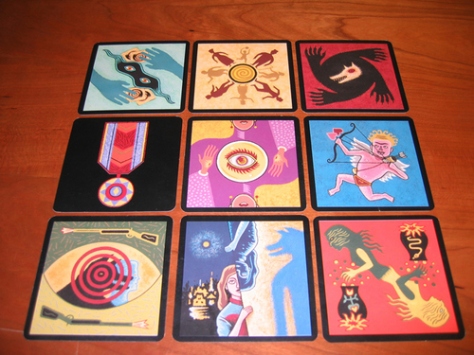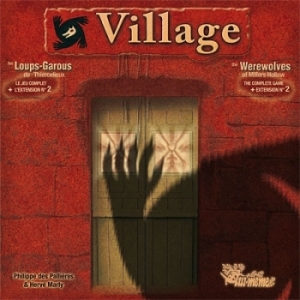If there is a person in the house who claims “I’m not a game person” (and every house seems to have at least one and often several), watch how they react when they witness a game of Cornerstone or Cornerstone Essential (Good Company Games, 2010). Cornerstone looks like a toy – and it probably could be considered a toy, except it comes with rules for up to four players and victory conditions, which means it’s really a game.
But this game has broader appeal precisely because of its toy-like qualities: it involves building with blocks and then using little people (meeples!) to climb on the resulting tower. How is that not fun?! The whole point of the game is essentially to be the king of the structure by the time it’s completed, or else to be at the highest point when the structure falls down. So it’s building blocks mixed with king-of-the-hill, and I challenge any fuddy-duddy daddy out there who thinks he’s too cool to play a game to ignore this while it’s going on. It can’t happen!
It isn’t a block-building free-for-all, however. Each player takes one of the four colors and two special wooden rings. The four-block neutral starter piece is laid on the table, and players start playing on it – and this is where it gets interesting. Each player has twelve building blocks with which to add to the structure, but the building blocks vary in terms of how many unit blocks they are composed of, and there are two of each. For example, there are two building blocks that consist of one unit block, two that consist of two unit blocks, and so on up to the two that consist of six unit blocks. On each turn the player must roll two dice, and the resulting roll of the two dice give the player two options for which building blocks to choose (doubles allow you to choose any block). If a player rolls a two and a four, for example, that player may choose to build with the 2-block building block or the 4-block building block.
The placement rules are such that, when adding to the structure, one full face of a block must be in contact with at least one other full face of the existing structure, such that the resulting structure retains a checkerboard pattern. In other words, a solid face must go against a clear face, and vice-versa; neither clear faces nor solid faces may touch each other. Once a block is added successfully, the player may (and should, if everything is going well) move his/her meeple to any spot perceived to be advantageous through the upcoming opponent turns. Meeples may move only one block at a time, any distance, but they may only move vertically if there is a single step with which to do it or horizontally if they are adjacent to that block. They may not jump up two or more blocks, and they must be directly below the vacant space they want to occupy (they may not move diagonally across and up in one turn). Meeples also may not move through a block that is occupied by another player.
That is the essence of Cornerstone! The “Essential” version is pretty new on the market (as I write this), and it contains the wooden rings, two of which are held by each player. They each represent a special move: when played, a ring allows a player to either jump two vertical levels instead of one, or else it allows a player to move through another player who may be blocking the path. These do alleviate the occasional problem of being totally sealed off on a ledge, or worse, a cave, thanks to other people’s blocks, but there are only two that each player can use throughout the game.
Although it doesn’t appear to be a game heavy in strategy, some players are extremely deliberate about which die roll they use, and precisely where to put the block they have chosen. If the tower is knocked down, the offending player has lost the game, and, of the other players, the one with the highest meeple at the time wins.
I like this game, and have listed it among my top ten family games because it is fun for members of every demographic. It can be played by kids alone, by teens alone, by adults alone, or else by the whole family at once. And it can be just as fun for each group alone. It’s a safe bet for ANYONE in the family!











































